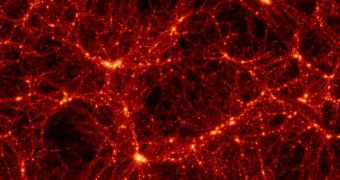Dark matter continues to remain just that elusive kind of matter much more present than regular one throughout the universe and which has not been observed directly yet. But some progress is being made, at least theoretically speaking, which bodes well for dark matter, since it is a theoretical item. The latest question that had to be answered linked to dark matter was whether its amount could be explained in relation to the anthropic principle and the multiverse concept.
It seems that life as we know it is due to the fact that the amount of dark matter in our universe is just right – not too small and not too large, at the same time. In comparison to the "normal" matter, the stuff everything we know is made of, from the tiniest creature to gas, oceans, stars and galaxies, dark mater is five to six times more abundant. Studies show that, given the fact that they formed in completely dissimilar ways after the Big Bang, the difference could've been a lot bigger, so life is very fortunate that the amounts were right.
The anthropic principle states that the features of the universe have to be fit for life to emerge, or else we wouldn't be here to wonder about it at all, and relies on the multiple universe concept in order to address the uncertainties related to the tuning of these characteristics. More specifically, each of the universes in the multiverse, including our own, has random properties. Ben Freivogel, from the University of California, Berkeley, studied the "misalignment angle" property of axions – particles that possess many characteristics associated with dark matter, except for that one.
The misalignment angle would have altered the quantity of dark matter generated after the Big Bang, as if it was randomly determined, the amount of dark matter would have been tremendously larger, to the detriment of the large formations of regular matter, like galaxies or galaxy clusters. And perhaps in other universes of the multiverse, this is even the case. But, as Freivogel's mixed calculations based on the cosmological models of the formation of large-scale structures and on the physics of axions indicate, for us, the conscious observers, the ratio is just perfect.

 14 DAY TRIAL //
14 DAY TRIAL //